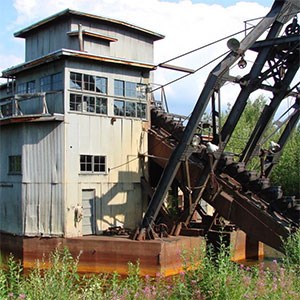
NPS Photo
The wide variety of mining processes employed in search of valuable mineral commodities has made for fascinating study in the 49th state. From the Klondike Gold Rush that spread to the Yukon, to the current gold "rush" in the beach placers of the Nome coast, evidence of mining is found throughout the Alaskan parks.
In the far north, placer mining of permafrost and hard rock mining resulted in a scattering of abandoned mine features that have deteriorated in the harsh climate, leaving many naturally reclaimed. In Denali, the Kantishna mining district comprises dozens of mining efforts representing various eras and stages of mining operations, both from hard rock and placer mining techniques. Hard rock mines are abundant in the mountains of Wrangell-St. Elias, with recognizable features that are found in many regions. Beach placer deposits have been staked along Alaska's extensive coastline in several episodes of furious activity. Interior Alaska saw both placer and hard rock mines for metals and coal. The large bucket line dredges that once plied the frozen ground of numerous drainages of the Yukon River country are representative of the industrious nature and fortitude of the Alaskan miner. These sites represent the mystique and lore of the hardy individualists that explored and settled the Alaskan wilderness, and a provide visitors with a tangible connection to the heritage preserved by these sites.
These sites also preserve many safety and environmental hazards that visitors unfamiliar with mining operations may not recognize as hazards. The remote location of these features intensifies the seriousness of injury that can occur at these sites, which are often the intended destination in a region of road-less wilderness. Additionally, as part of the history of Alaskan settlement, many sites have interpretive displays or information for park visitors.
From the thousands of mining claims that existed at the time of the establishment of the Alaska park units, several hundred still remain within park units. Since 1981, the Alaska region has worked to quantify the number and type of hazards posed by these sites and has pursued a variety of solutions to mitigate these issues. A number of mine entrances were closed by PUF methodologies or installation of lightweight steel gates in the late 1980s and early 1990s in partnership with the State of Alaska AML Program, and the Office of Surface Mining. Congressional set asides through the American Recovery and Reinvestment Act (ARRA) in 2009 and 2010 provided funding for the mitigation of high-risk physical safety hazards posed to visitors and NPS employees at mine sites. With these funds, the Alaska Region aggressively tackled a backlog of safety issues and mitigated hazards at numerous locations throughout the region, including two closures in Denali, seven closures in Kenai Fjords, and eight closures in Wrangell-St. Elias.
It was recognized that the ARRA funds made available were insufficient to deal with the magnitude of the AML issue on NPS lands. At the conclusion of this effort, PMIS project 164526 was proposed to fund a service-wide comprehensive inventory during 2011-2012 to address this issue.
Assessment research and fieldwork to accomplish the goals of the project began in October of 2010, following the conclusion of the ARRA projects. Site visits were prioritized using several factors: The highest-priority sites were those reported to have abandoned explosives. Next were sites with known or suspected open underground workings, or hazardous materials such as chemicals or petroleum products. Mine features in AKRO parks were researched and assessed for stability, hazards, and future mitigation requirements. Park-specific reports for several parks as an additional product deriving from the field efforts and inventory research were also prepared. Final data was reported to the AML database in October, 2012. This information will serve as the basis for future AML funding requests and mitigation efforts.
Due to the limited timeframe with respect to this project schedule, access to these sites was primarily through the use of helicopter-based operations. Many locations in Glacier Bay National Park were accessed through boat-supported operations, as well as several in Yukon-Charley Rivers National Preserve. Logistical support for this effort contributed a large portion of the project costs.
Current Concerns
The most pressing need in the AKRO is to continue to mitigate hazardous conditions to ensure visitor safety, reclaim mining-impacted landscapes to restore natural processes, and provide for preservation of cultural resources and essential wildlife habitat.
There remains a large number of AMLs requiring mitigation in AKRO parks. Future funding for features identified as high priority should allow for project managers to combine resources and logistical support to achieve greater efficiencies of mitigation activities where logistics and methodologies are similar.
The remote nature of these sites would seem to make the hazards posed by these sites much lower, but in fact the extreme remoteness greatly increases the danger that an injury suffered at these locations becomes life or limb-threatening in the absence of immediate medical attention. The simple fact that the only access through a wilderness area may be following the vestiges of a 100 year old road that leads directly to an open adit invalidates arguments that these sites pose less danger because they are so remote.
Last updated: February 8, 2016
